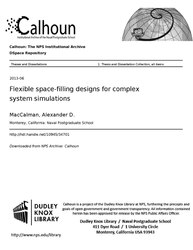File:Flexible space-filling designs for complex system simulations (IA flexiblespacefil1094534701).pdf

Original file (1,275 × 1,650 pixels, file size: 6.23 MB, MIME type: application/pdf, 148 pages)
Captions
Captions
Summary
[edit]| Flexible space-filling designs for complex system simulations
( |
||
|---|---|---|
| Author |
MacCalman, Alexander D. |
|
| Title |
Flexible space-filling designs for complex system simulations |
|
| Publisher |
Monterey, California: Naval Postgraduate School |
|
| Description |
In order to better understand the complex nature of a system, analysts need efficient experimental designs that can explore high-dimensional simulation models with multiple outputs. These simulation models are critical to the early phases of system design and involve complicated outputs with a wide variety of linear and nonlinear response surface forms. The most common response surface form for analyzing complex systems is the second-order model. Traditional designs that fit second-order response surface models do not effectively explore the interior of the experimental region and cannot fit higher-order models. We present a genetic algorithm that constructs space-filling designs with minimal correlations between all second-order terms for a mix of continuous and discrete factor types. These designs are specifically suited to fit the second-order model with excellent space-filling properties and are flexible enough to fit higher-order models for a modest number of factors; these high-order terms are what characterize the system complexities. We demonstrate the utility of these designs with a Model-Based Systems Engineering application that integrates multiple simulation outputs to form a trade-off environment for a system design. This research enables the simulation analysis and system design community to better understand the complex nature of multiple simulation outputs. Subjects: Computer Experiments; Design of Experiments; Genetic Algorithm; Latin Hypercube; Response Surface Methodology; Nearly Orthogonal |
|
| Language | English | |
| Publication date | June 2013 | |
| Current location |
IA Collections: navalpostgraduateschoollibrary; fedlink |
|
| Accession number |
flexiblespacefil1094534701 |
|
| Source | ||
| Permission (Reusing this file) |
This publication is a work of the U.S. Government as defined in Title 17, United States Code, Section 101. As such, it is in the public domain, and under the provisions of Title 17, United States Code, Section 105, may not be copyrighted. | |
Licensing
[edit]| Public domainPublic domainfalsefalse |
This work is in the public domain in the United States because it is a work prepared by an officer or employee of the United States Government as part of that person’s official duties under the terms of Title 17, Chapter 1, Section 105 of the US Code.
Note: This only applies to original works of the Federal Government and not to the work of any individual U.S. state, territory, commonwealth, county, municipality, or any other subdivision. This template also does not apply to postage stamp designs published by the United States Postal Service since 1978. (See § 313.6(C)(1) of Compendium of U.S. Copyright Office Practices). It also does not apply to certain US coins; see The US Mint Terms of Use.
|
 | |
| This file has been identified as being free of known restrictions under copyright law, including all related and neighboring rights. | ||
https://creativecommons.org/publicdomain/mark/1.0/PDMCreative Commons Public Domain Mark 1.0falsefalse
File history
Click on a date/time to view the file as it appeared at that time.
| Date/Time | Thumbnail | Dimensions | User | Comment | |
|---|---|---|---|---|---|
| current | 16:28, 20 July 2020 |  | 1,275 × 1,650, 148 pages (6.23 MB) | Fæ (talk | contribs) | FEDLINK - United States Federal Collection flexiblespacefil1094534701 (User talk:Fæ/IA books#Fork8) (batch 1993-2020 #16802) |
You cannot overwrite this file.
File usage on Commons
The following page uses this file:
Metadata
This file contains additional information such as Exif metadata which may have been added by the digital camera, scanner, or software program used to create or digitize it. If the file has been modified from its original state, some details such as the timestamp may not fully reflect those of the original file. The timestamp is only as accurate as the clock in the camera, and it may be completely wrong.
| Short title | Flexible space-filling designs for complex system simulations |
|---|---|
| Author | MacCalman, Alexander D. |
| Software used | MacCalman, Alexander D. |
| Conversion program | Acrobat Distiller 10.1.4 (Windows) |
| Encrypted | no |
| Page size | 612 x 792 pts (letter) |
| Version of PDF format | 1.4 |

